The Southwest Disk Discada Reviewed
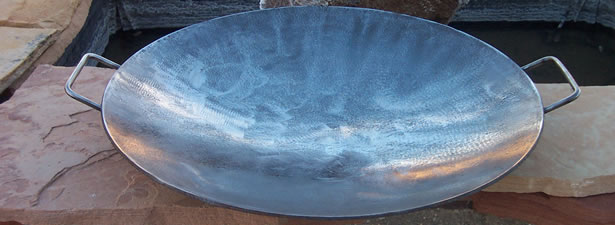
Marketing from Southwest Disk
With traditional styling and a full 22-inches of cooking space, our concave plow disk is designed to provide owners with a streamlined valley look while giving them quality to last a lifetime. Our disks have already been deep-seasoned and fired before they are ever shipped to your door so they are ready to use immediately, no waiting around. Two beautifully crafted handles give you great maneuverability over this 22-pound, 1/4″-thick fully-seasoned disco cooker.
Manufacturer: Southwest Disk, southwestdisk.com
Model: Southwest Disk DiscadaMaterials: Pre-seasoned Hardened Steel Plow Disk
Dimensions: 22″ diameter
Weight: 22 lbsMSRP: $65.00
The Review
As an avid outdoor chef wannabe, I am always on the lookout for gadgets and grills to broaden my horizon by expanding my culinary repertoire and skill set. Especially with Southwest and Asian cuisines. A few years ago, I heard about discada cooking. I watched dozens of videos before finally deciding to get one for myself. But after trying out a bunch of different options and much deliberation, my heart was set on an authentic hardened steel plow disk. I contacted David over at Southwest Disk and he sent one right over. Now I can let you in on the secret of incredible discada cooking…
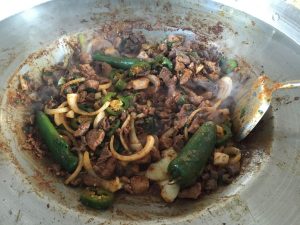 Discada is a mixed meat dish popular across the southwestern part of the United States and northern Mexico. Traditionally, it was cooked on an agricultural plow disk harrow, hence its name. Over the years, the plow disk itself has come to be referred to as a discada, AKA the Cowboy Wok.
Discada is a mixed meat dish popular across the southwestern part of the United States and northern Mexico. Traditionally, it was cooked on an agricultural plow disk harrow, hence its name. Over the years, the plow disk itself has come to be referred to as a discada, AKA the Cowboy Wok.
My first discada was a flat-bottom stainless steel disk with stainless handles riveted on. I thought it would be a good choice for me because it was lightweight and it would be easy to clean. But what I found was that it was extremely difficult to control the temperature because the stainless was so thin, and the dissipation of heat was rather poor causing the disk to warp all the time.
I tried using it over a large stove burner, a fire pit, and even sitting atop a barbecue grill in an attempt to gain control over the heat. I even designed an adapter ring so I could use my discada with a Volcano Grill and a Weber Smokey Joe. But none of those options afforded me the level of control that I was looking for with that stainless disk.
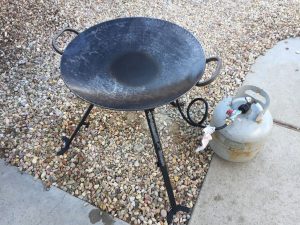 Around same time, I also found myself cooking more and more on a cast iron skillet. I love the way they heat evenly across the bottom of the pan, and they stay hot much longer than typical modern cookware. Not to mention, they are really easy to clean and maintain, and tough as nails so there is no need to worry about scratching or burning them either Just keep them clean and oiled, and they’ll last many lifetimes.
Around same time, I also found myself cooking more and more on a cast iron skillet. I love the way they heat evenly across the bottom of the pan, and they stay hot much longer than typical modern cookware. Not to mention, they are really easy to clean and maintain, and tough as nails so there is no need to worry about scratching or burning them either Just keep them clean and oiled, and they’ll last many lifetimes.
That is when I decided to start looking for a traditional plow disk discada. I found a few places where I could purchase my own disk, plug the holes, weld the handles on and season it myself, but I wasn’t really interested in another project. I also ran across a few disks readymade disks from various companies but settled on Southwest Disk because it was the only manufacturer providing complete pre-seasoned disks in a number of various configurations that are ready to use the moment they arrive. All disks are thoroughly prepped and cleaned prior to its first deep seasoning and firing so you don’t have to.
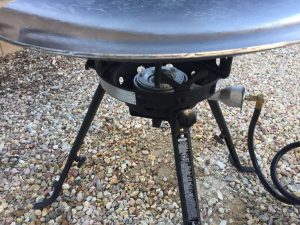 The model that I received was a 22″ disk with a deep concave valley providing nearly 400 square inches of cooking area. It had traditional steel handles welded solidly on two opposing sides making it easy to carry and maneuver around. The plow disks that Southwest Disk uses are nearly 1/4″ thick so they are extremely rugged and should last a lifetime, but also a little heavy at 22-pounds as a result. They also have smaller 18″ and larger 24″ models with a full assortment of handle options from loops to horseshoes, and even bbq springs.
The model that I received was a 22″ disk with a deep concave valley providing nearly 400 square inches of cooking area. It had traditional steel handles welded solidly on two opposing sides making it easy to carry and maneuver around. The plow disks that Southwest Disk uses are nearly 1/4″ thick so they are extremely rugged and should last a lifetime, but also a little heavy at 22-pounds as a result. They also have smaller 18″ and larger 24″ models with a full assortment of handle options from loops to horseshoes, and even bbq springs.
Some Southwest Disks can be purchased with short legs welded on like their Roswell UFO Discada models. These are perfect for cooking over an open campfire. They also sell a few popular models of propane burners. My disk came with an amazing Portable Adjustable-Height Burner. It was easy to setup and very sturdy. I love the fact that I can raise it to waist-level or drop it down if I want to put it up on a table or cook lower to the ground. The propane burner is fully adjustable so you can get just the right amount of heat to the disk. It uses a common orifice so converting it to natural gas should be a snap.
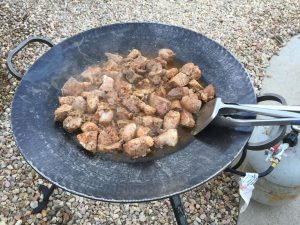 For my first attempt at using the disk from Southwest, I decided to make some carnitas. Something that I had trouble getting right with the stainless disk. After setting up the propane burner in an area of the yard where any splatter would not be an issue, I cleaned and oiled the disk and placed it over the burner… All set to go!
For my first attempt at using the disk from Southwest, I decided to make some carnitas. Something that I had trouble getting right with the stainless disk. After setting up the propane burner in an area of the yard where any splatter would not be an issue, I cleaned and oiled the disk and placed it over the burner… All set to go!
Carnitas My Way
The recipe calls for 5-pounds of pork shoulder cut into 2″ cubes so they cook evenly. Pork shoulder and pork butt are really the same cut. Once they are all cut, coat them with a healthy amount of dry-rub mixture consisting of salt, pepper, cumin, garlic powder, cayenne pepper, and oregano, then place them back in the refrigerator to cool. Next, you add two-pounds of lard to the disk and light the burner, adjusting it to a medium flame. Once all of the lard has melted and come up to temperature, slowly add the pork cubes in with a pair of tongs. Be very careful not to drop them into the hot oil or it will surely splash.
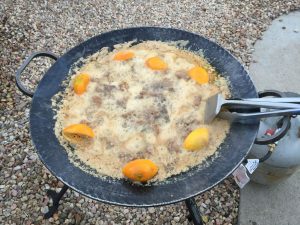 Keep turning the cubes until they are all a consistent golden brown color. If some are cooking faster than others, simply push them up the disk and out of the oil. Once all of the cubes are cooked, add 20-ounces of water, 8-ounces of Coke or Dr Pepper, a cup of sweetened condensed milk, 3 cinnamon sticks, 1/2 onion coarsely chopped and 1 bay leaf, followed by three medium-sized oranges cut in half and squeezed over the top. You can throw them in for good measure while it cooks down. This should take about 60-90 minutes.
Keep turning the cubes until they are all a consistent golden brown color. If some are cooking faster than others, simply push them up the disk and out of the oil. Once all of the cubes are cooked, add 20-ounces of water, 8-ounces of Coke or Dr Pepper, a cup of sweetened condensed milk, 3 cinnamon sticks, 1/2 onion coarsely chopped and 1 bay leaf, followed by three medium-sized oranges cut in half and squeezed over the top. You can throw them in for good measure while it cooks down. This should take about 60-90 minutes.
If you like your carnitas a little spicy, I highly recommend adding a couple small serrano or jalapeno peppers finely chopped to the mixture. Just don’t add the seeds and veins if you are worried about it being too hot. The peppers provide just enough bite to notice them, but the sweetness of the candied pork from the Dr. Pepper and condensed milk smooth it out so even young kids would happily enjoy it. I like mine firmly on the hotter side so I tend to leave the seeds and the veins in, sometimes adding another pepper or two when I’m feeling adventurous.
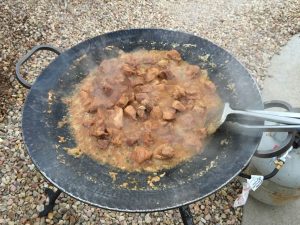 It may be necessary to add some water from time to time as it cooks down. Carnitas is simply twice-cooked pork so the idea is that it should cook the second time long enough to tenderize the meat to the point of it falling apart, but the liquid must also reduce and coat the pork with a candied coating without burning. I’ve even used plain old pork stew meat which often pretty tough. But when it is cooked this way, it softens right up. Though, for best results, pork shoulder/butt is absolutely the best choice.
It may be necessary to add some water from time to time as it cooks down. Carnitas is simply twice-cooked pork so the idea is that it should cook the second time long enough to tenderize the meat to the point of it falling apart, but the liquid must also reduce and coat the pork with a candied coating without burning. I’ve even used plain old pork stew meat which often pretty tough. But when it is cooked this way, it softens right up. Though, for best results, pork shoulder/butt is absolutely the best choice.
Once the pork is ready and falling apart, I like to crisp it just a little before pulling it from the grill. This step only adds to the depth of the flavor and the texture. Next, I pull the pork from grill, placing it in a large stainless steel bowl. I like to use a large stainless steel bowl to hold the pork as I shred it apart with two large forks. This allows me to keep the mess to a minimum. I typically let it stand for about 5-10 minutes before shredding up the carnitas so it won’t dry out as quickly.
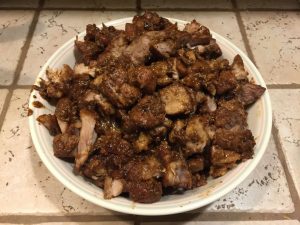 Sometimes I make a rich handmade red chile sauce with fresh garlic, tomatoes, onions, and plenty of arbol, ancho, guajillo and pasilla chiles to top the carnitas with. But honestly, it is not at all necessary with this recipe.
Sometimes I make a rich handmade red chile sauce with fresh garlic, tomatoes, onions, and plenty of arbol, ancho, guajillo and pasilla chiles to top the carnitas with. But honestly, it is not at all necessary with this recipe.
Cleaning a discada is no more difficult than cleaning a cast iron skillet. Simply add about a half-liter of water to the discada, let it get good and hot, then with high-temp silicone gloves on, lightly scour it with a 316L stainless steel chain mail scrubber until you feel all of the crusty bits of food that was burnt on has loosened. It should come loose without much effort. Finally, you rinse and dry the disk thoroughly before wiping it down with some lard or non-gumming cooking oil and place it over medium heat until it has been absorbed. This will prevent it from rusting. It is also important not so store them in a dry location where they won’t get wet.
Southwest Disk also hosts a website full of modern and authentic discada recipes for your enjoyment, and don’t forget to share your cookouts with them on their Facebook Page.
Final Thoughts
I’ve cooked everything from carnitas and a traditional discada recipe to regular pork chops and some stir-fry Asian dishes on this disk, and I absolutely love it. The heat is easy to control and the dissipation is ideal for what I need, similar to that of a cast iron skillet, making it really easy to cook on. I’ve even successfully made an amazing pork-fried rice on it. I try to use it whenever I can because it is so enjoyable to cook on.
The portable burner is ideal for taking the thing out to a campsite or tailgating before a game. At 22 pounds, there should be no misconception about packing it somewhere. All said, there is nothing like cooking on a discada, and no way I would ever consider giving it up. Two thumbs way up!
You can always find this and other discadas from Southwest Disk at Amazon or on their website.
![]()
About Southwest Disk
 Southwest Disk is a small veteran-owned company located in Albuquerque, New Mexico bringing the secrets of the Southwest to the world… Experience savory Southwest cooking at home, camping, tailgate parties or RV’ing with our handcrafted discada discs.
Southwest Disk is a small veteran-owned company located in Albuquerque, New Mexico bringing the secrets of the Southwest to the world… Experience savory Southwest cooking at home, camping, tailgate parties or RV’ing with our handcrafted discada discs.
Our Discada plow disc cookers are handcrafted and prepared right here in New Mexico, the heart of the Southwest, for your ultimate culinary experience. Be sure to check out our selection of Discada plow disk cookers and a host of disc burners/fryers, lids, covers and kits.
--